-
(applied modeling of computational fluid dynamic for eco-lab concentration changes with sediment transport (case study shadegan lake
جزئیات بیشتر مقاله- تاریخ ارائه: 1392/07/24
- تاریخ انتشار در تی پی بین: 1392/07/24
- تعداد بازدید: 735
- تعداد پرسش و پاسخ ها: 0
- شماره تماس دبیرخانه رویداد: -
the simulation of hydrodynamics and transport of different substances in lakes and reservoirs is a developing tool in order to predict their internal processes and interactions. computational fluid dynamic (cfd) modeling allows the combination of these factors to calculate the behavior of all different configurations. in this research modeling of the hydrodynamic flow of heavy metal concentration that is in variation with sediment transport was analyzed. the finite volume method is used to descrete the governed equations of the model. accordingly, for the modeling of the parameters carried out in the finite volume method. two-dimensional depth-integrated model mike 21 was used in this study to simulate hydrodynamic and advection-dispersion processes in a full-scale flow. shallow water equations are used for this purpose, since the scale of features in the horizontal direction is much greater than the vertical, also lakes are much larger in length and width than they are in depth, and flows of water in the volume are predominantly horizontal. the shallow water equations are applied for more efficient numerical solution of flow in this environment. furthermore equations describing the transport and fate of constituents in the water such as contaminants with sediment can be coupled to the hydrodynamic equations. case study should have appropriate some data for modeling the hydrodynamic of flow, then should be analyzed with numerical method in mike 21. accurate modeling depends on a time history of water surface elevation, current velocity, temperature and salinity. the data for simulation, prepared as time series and line series data, is combined together in the model. the benefits of mike 21is that the model contains interaction between hydrodynamic flow and eco-lab module in simulation. beside this, it involves sand and sediment transport. after the initial run of the software, analyzing the hydrodynamic and eco-lab module parameters has taken into account. the calibration of parameters by proposed amounts of software manual packs, were edited. finally, adjusting the optimized amounts for both modules in simulation, the last run of model has done. output data compared with observed data for accurate discussion. output is consist of different parameters in which operator can combine them or plotted each outcome separately. for precise results, considering parallel parameters such as hydrodynamic flow of heavy metals and sediment transport made into an applicable conclusion. by comparison of verified data and observed data of the real case, it seems that the model is compatible with the parameters of hydrodynamic and eco-lab in real data's.
مقالات جدیدترین رویدادها
-
استفاده از تحلیل اهمیت-عملکرد در ارائه الگوی مدیریت خلاقیت سازمانی و ارائه راهکار جهت بهبود
-
بررسی تاثیر ارزش وجوه نقد مازاد بر ساختار سرمایه شرکت های پذیرفته شده در بورس اوراق بهادار تهران
-
بررسی تأثیر سطح افشای ریسک بر قرارداد بدهی شرکت های پذیرفته شده در بورس اوراق بهادار تهران
-
بررسی تأثیر رتبه بندی اعتباری مبتنی بر مدل امتیاز بازار نوظهور بر نقد شوندگی سهام با تأکید بر خصوصی سازی شرکت ها
-
تأثیر آمیخته بازاریابی پوشاک ایرانی بر تصویر ذهنی مشتری پوشاک ایرانی (هاکوپیان)
-
معرفی و مقایسه روش های تعیین سرفاصله در حمل و نقل همگانی
-
چگونگی ایفای نقش بانک مرکزی در بازارهای ارز و پول
-
تحلیل پایداری قطار شهری شیراز با استفاده از نرم افزار twofs و مقایسه با روابط تجربی
-
natural convection from inclined plates to gases and liquids when both sides are uniformly heated at the same temperature
-
effect of near- field ground motions on the stability of embankment dams
مقالات جدیدترین ژورنال ها
-
مدیریت و بررسی افسردگی دانش آموزان دختر مقطع متوسطه دوم در دروان کرونا در شهرستان دزفول
-
مدیریت و بررسی خرد سیاسی در اندیشه ی فردوسی در ادب ایران
-
واکاوی و مدیریت توصیفی قلمدان(جاکلیدی)ضریح در موزه آستان قدس رضوی
-
بررسی تاثیر خلاقیت، دانش و انگیزه کارکنان بر پیشنهادات نوآورانه کارکنان ( مورد مطالعه: هتل های 3 و 4 ستاره استان کرمان)
-
بررسی تاثیر کیفیت سیستم های اطلاعاتی بر تصمیم گیری موفق در شرکتهای تولیدی استان اصفهان (مورد مطالعه: مدیران شرکتهای تولیدی استان اصفهان)
-
بررسی تاثیر چابکی سازمانی و خلاقیت سازمانی بر عملکرد شغلی کارکنان بانک توسعه صادرات ایران
-
اصطلاحات نجومی و بازتاب آن در شعر برخی از شاعران
-
«فمنیسم پسااستعماری و جنبش متقدم زنان در ایران» دیگری سازی و مناسبات سلطه
-
مدلی برای تحقق اهداف اقتصاد مقاومتی در بیمارستان (مطالعه موردی: بیماران مبتلا به بیماری های خاص)
-
the study of electron-orbital properties of bipolar energy of complex (2,6-diaminopyridinium bis (4-hydroxy-pyridine-2,6,6-dicarboxylate) dihydrate chromate iii))) with alteration of ligands by computational methods




سوال خود را در مورد این مقاله مطرح نمایید :